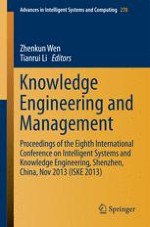"Knowledge Engineering and Management" presents selected papers from the 2013 International Conference on Intelligent Systems and Knowledge Engineering (ISKE2013). The aim of this conference is to bring together experts from different expertise areas to discuss the state-of-the-art in Intelligent Systems and Knowledge Engineering, and to present new research results and perspectives on future development. The topics in this volume include, but not limited to: Knowledge Representation and Modeling, Knowledge Maintenance, Knowledge Elicitation, Knowledge-Based Systems (KBS), Content Management and Knowledge Management Systems, Ontology Engineering, Data Mining and Knowledge Discovery, Knowledge Acquisition, etc. The proceedings are benefit for both researchers and practitioners who want to utilize knowledge engineering methods in their specific research fields.
Dr. Zhenkun Wen is a Professor at the College of Computer and Software Engineering, Shenzhen University, China. Dr. Tianrui Li is a Professor at the School of Information Science and Technology, Southwest Jiaotong University, Xi’an, China.
